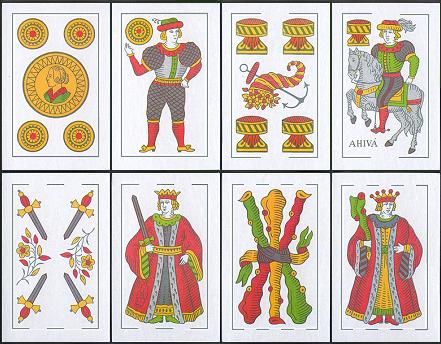The Philippines are among the few Asian countries where the use of the
Cadíz pattern is still reported; the game played with these cards is called
Cuajo. Regretfully, the game has almost become obsolete, and the locals who know how to play are very scarce.
The Philippines used to be a Spanish colony up to the late 1800s; this gives reason for the use of the
Cadíz pattern, but the rules of the game came from the Far East. Traders from China are known to have reached the Philippines as early as the 11th century, and other clues too seem to indicate that the origin of
Cuajo is almost certainly Chinese.
The deck has a very special composition. Each suit consists of seven subjects only: ace, 3, 4, 5, knave, cavalier and king; for each subject there are four identical cards, so their total number is 7 x 4 suits x 4 times = 112. This matches perfectly the composition of the so-called Four Colour cards (see page 3 of the Chinese gallery). |
 |
In second place, the rules of
Cuajo have much in common with those of
Mah Jong, Si Se Pai, Ceki (see
Indonesia and Malaysia) and others belonging to the same group: taking turns, the players pick one undealt card, discard one of theirs, and try to complete simple combinations such as three aces, three 5s, etc., or series (3-4-5, etc.) in order to close the hand.
Furthermore, the same word
Cuajo is Chinese. In Spanish it means "clot", but referred to the game, this name seems a translitteration of an indigenous one. A Chinese game called
Kwa Oh, i.e. the same pronounciation as
Cuajo in Spanish, played with Four Colour cards, has been reported in the playing card literature, although its rules are not known; the spelling of this game's name in Chinese glyphs is

.
 |
Interestingly, the same two glyphs, according to the main language spoken in China, i.e. Mandarin, sound Kan Hu; also a game with this name was reported by sinologist Wilkinson, by the turn of the 20th century (see more about his research on Chinese cards in China, page 1); Wilkinson even created a card game of his own, based on the original one, which he called Kanhoo, evidently bearing in mind the Chinese name, and marketed it in the Western world. |
We do not know whether
Kwa Oh and
Kan Hu were the same game. The characters used by Wilkinson for spelling Kan Hu are

, which partly mismatch the aforesaid ones. This is only apparently a controversy, as in both names the glyphs have no real meaning (the first one translates "looking at the lake", the second one "looking at a pot"): they are used phonetically, i.e. only to produce a given sound. Since

and

are pronounced exactly in the same way, there is no real difference between the two names.
The special deck for playing
Cuajo is only made by the Spanish manufacturer Fournier. The cards have sharp corners, as most
Cadíz editions have.